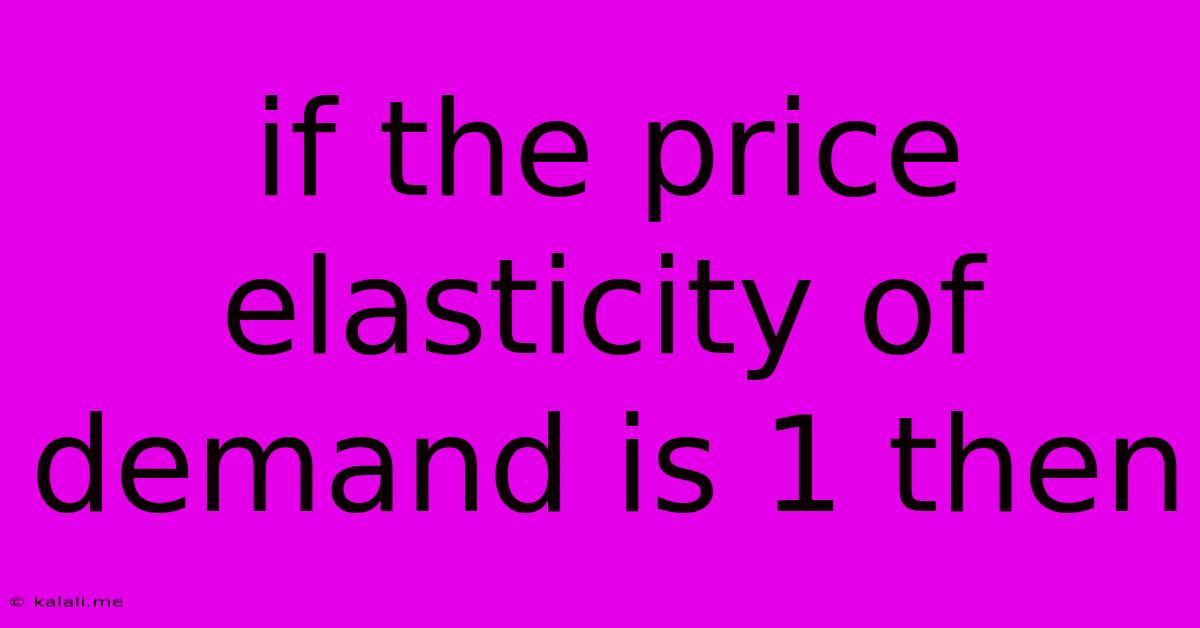If The Price Elasticity Of Demand Is 1 Then
Kalali
Jun 14, 2025 · 3 min read

Table of Contents
If the Price Elasticity of Demand is 1: Understanding Unitary Elastic Demand
Price elasticity of demand (PED) is a crucial concept in economics, measuring the responsiveness of quantity demanded to a change in price. Understanding PED helps businesses make informed pricing decisions and predict market reactions. This article delves into the implications of a PED of 1, also known as unitary elastic demand.
What does a price elasticity of demand of 1 mean? A PED of 1 signifies that a percentage change in price results in an equal percentage change in quantity demanded. In simpler terms, if the price increases by 10%, the quantity demanded will decrease by 10%, and vice versa. This indicates a balanced relationship between price and quantity demanded. Total revenue remains unchanged despite price fluctuations.
Characteristics of Unitary Elastic Demand
Several key characteristics define markets exhibiting unitary elastic demand:
- Balanced Responsiveness: Consumers are equally sensitive to price changes. A small price increase leads to a proportionally equivalent reduction in demand, and the opposite is true for price decreases.
- Constant Total Revenue: A defining feature is the unchanging total revenue (price x quantity). Regardless of whether the price increases or decreases, the total revenue stays the same. This is because the percentage change in price is offset exactly by the percentage change in quantity demanded.
- Mid-Range Sensitivity: Unitary elasticity often represents a middle ground in terms of price sensitivity. Products with highly elastic demand (PED > 1) are more sensitive to price changes, while those with inelastic demand (PED < 1) are less sensitive.
- Relatively Few Products: While theoretically possible, finding perfectly unitary elastic demand in the real world for extended periods is rare. Most goods and services exhibit varying degrees of elasticity depending on factors like price levels, availability of substitutes, and consumer income.
Examples of (Near) Unitary Elastic Demand
While true unitary elasticity is hard to pinpoint, certain goods and services might temporarily exhibit characteristics close to it. This often depends on the specific market conditions and price point. For instance:
- Specific Branded Products: A popular brand of clothing might experience near-unitary elasticity at a particular price point. A slight increase could cause some consumers to switch to alternatives, leading to a proportional drop in sales.
- Luxury Goods (at certain price points): High-end goods often demonstrate variations in PED. At specific price points, a small increase may lead to proportionally similar demand reduction as consumers become more price-conscious.
Implications for Businesses
For businesses, understanding unitary elasticity is crucial for:
- Revenue Management: Since total revenue remains constant, focusing solely on price changes to boost revenue isn't effective. Strategies should focus on other aspects like marketing, product differentiation, or improving customer experience.
- Pricing Strategies: While price adjustments won't directly impact total revenue, they could influence market share or brand perception. Careful consideration of the overall market dynamics is necessary.
- Demand Forecasting: Accurate prediction of demand changes based on price adjustments becomes crucial for inventory management and production planning.
Factors Affecting Price Elasticity of Demand
Several factors influence the price elasticity of demand, including:
- Availability of substitutes: The more substitutes available, the higher the elasticity.
- Necessity versus luxury: Necessities tend to have inelastic demand, while luxuries are usually more elastic.
- Proportion of income spent: Goods representing a small portion of income generally have inelastic demand.
- Time horizon: Demand is often more elastic in the long run than in the short run.
In conclusion, a price elasticity of demand of 1 represents a balanced relationship between price and quantity demanded, resulting in constant total revenue. Understanding this concept allows businesses to make more strategic decisions regarding pricing, marketing, and overall business planning. Although perfectly unitary elasticity is rare, recognizing the characteristics and implications of this scenario provides valuable insight into market dynamics and consumer behavior.
Latest Posts
Latest Posts
-
Which Of The Following Is Not An Application Layer Protocol
Jun 14, 2025
-
Which Of The Following Is A Renewable Energy Source Weegy
Jun 14, 2025
-
Select All Correct Statements On Whistleblowing
Jun 14, 2025
-
What Is The Percentage Of 300
Jun 14, 2025
-
Which Of The Following Is Radially Symmetrical
Jun 14, 2025
Related Post
Thank you for visiting our website which covers about If The Price Elasticity Of Demand Is 1 Then . We hope the information provided has been useful to you. Feel free to contact us if you have any questions or need further assistance. See you next time and don't miss to bookmark.